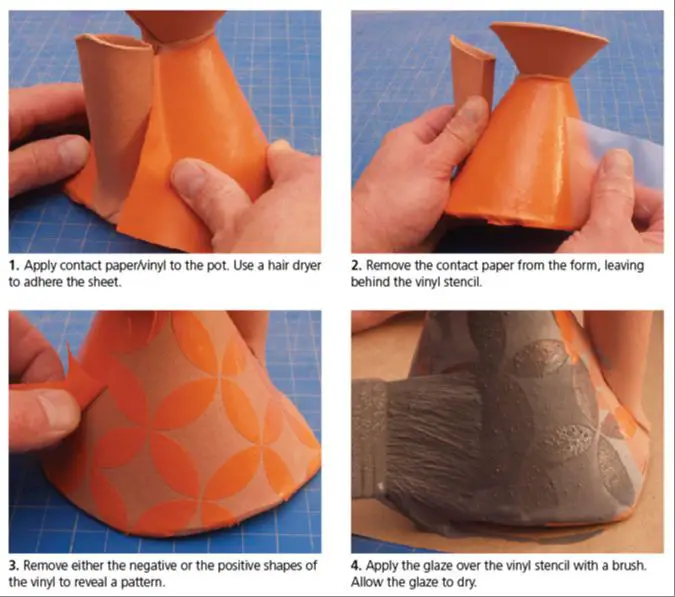How To Make A Leaf Imprint On Clay?
Leaf imprinting on clay is a fun and creative way to make decorative crafts, jewelry, tiles, and more. By pressing leaves into soft clay, you can copy the shape, veins, and texture onto the clay surface. When the clay is fired or dried, a beautiful imprint of the leaf remains.
Leaf imprints add lovely, organic designs to clay surfaces. Since no two leaves are exactly alike, each imprint results in a unique work of art. Leaf imprints allow you to incorporate natural beauty into clay crafts. They are perfect for decorative and artistic touches on pottery, ornaments, plates, beads, and more.
Another benefit of leaf imprinting is that it allows you to preserve the veining and shape of special leaves into lasting keepsakes. You can imprint a leaf from your backyard tree, favorite garden plant, or meaningful shade tree. Leaf imprinting immortalizes leaves’ shapes and designs into clay crafts that can be enjoyed for years to come.
Gather Materials
Before making leaf imprints in clay, you’ll need to gather a few simple supplies:
- Clay – Polymer clay or air-dry clay work best. Make sure you have enough clay for the size of project you want to make.
- Leaves – Collect a variety of fresh leaves, either from your yard or on a nature walk. Look for leaves with interesting shapes and vein patterns.
- Rolling pin – Needed to roll out the clay into a flat even surface before imprinting.
- Clay sculpting tools – Things like wooden skewers, toothpicks, and cups can create lines, textures, and shape the clay.
Once you have your clay, leaves, and tools gathered, you’re ready to start imprinting!
Prepare the Clay
Before making imprints in clay, it is important to prepare it properly. Start by taking out the amount of clay you need and kneading it for a few minutes to warm it up. If the clay is stiff or dry, add a few drops of water and knead it in to condition the clay. The clay should be smooth, soft, and pliable without being sticky.
Once the clay is conditioned, use a rolling pin or acrylic roller to roll it out into a flat slab. The slab should be around 1/4 inch thick – not too thin that it becomes fragile or too thick that the leaf details won’t impress well. Work methodically and apply even pressure as you roll to achieve an even thickness. The slab should be larger than the imprint design size so you have room to work. Smooth any cracks or seams in the surface before making imprints.
Select and Prepare Leaves
When selecting leaves to use for imprinting, look for ones with interesting vein patterns or leaf shapes that will leave distinctive impressions in the clay. Avoid leaves that are torn, curled, or otherwise damaged. Collect leaves that are fully intact.
Wash the leaves by gently rubbing both sides under running water or lightly scrubbing them with a soft brush to remove any dirt. Be careful not to tear the leaf. Pat the leaves dry with a paper towel or allow them to air dry on a towel. Spread the leaves out in a single layer, without overlapping. Let the leaves dry completely before using them to imprint the clay. The leaves should not be damp or they may stick to the clay.
Choose leaves that are not too thick, or they will not imprint well. Thin, supple leaves like maple leaves make excellent impressions. Gather a selection of leaf shapes and sizes to create visual interest in your clay design.
Make the Imprint
Once you have gathered your leaves and prepared the clay, you are ready to make the leaf imprints. The key steps for a successful imprint are:
- Place your clay on a flat work surface. Use your fingers or a rolling pin to flatten it into a slab about 1/4-1/2 inch thick.
- Choose a leaf with an interesting vein pattern and place it vein side down on the clay. Position it where you want the imprint to be.
- Gently press the leaf into the clay, applying even pressure with your fingers across the leaf surface. Press firmly enough so the leaf veins and edges make an impression, but not so hard that the clay sticks to the leaf.
- After 10-30 seconds, carefully peel the leaf off the clay by lifting from one edge. Go slowly so the imprint remains intact.
Examine the imprint closely. If needed, re-press any areas that did not pick up the leaf details well enough. The vein patterns should show clearly in the clay.
Repeat with More Leaves
Continue imprinting leaves, spacing them out aesthetically on the clay. Make sure to press firmly and evenly when imprinting to fully transfer the leaf details into the clay. Vary the placement, alternating directions and angles. Leave plenty of space between the leaf imprints to allow the designs to stand out.
Aim for balance in your overall composition. Keep adding leaves until you fill the clay as desired. Remember, you can continue imprinting leaves even as previous ones dry and harden. Overlap leaves and layer multiple impressions in some areas for added interest and texture.
Be creative and try imprinting leaves in patterns, groupings, or trails across the clay. Consider alternating leaf varieties as well for more diversity in the imprinted designs. Don’t worry about perfection – the unique organic shapes and lines of the leaves will give your project a natural look.
Refine the Design
Once you have imprinted all the leaves into the clay, you can use various clay tools to refine the design and make it your own. Here are some ideas for ways to enhance the leaf imprinting:
- Use clay sculpting tools, toothpicks, or popsicle sticks to gently etch lines into the clay around or between the leaf imprints. This can help define the leaf shapes or add interesting texture.
- Use a roller tool or the back of a paintbrush to add patterns like swirls, dots, or waves into areas of the clay. Press gently so you don’t flatten the leaf imprints.
- Cut out simple shape like circles, squares or triangles from extra clay and add them to the design. Press gently around the edges to adhere them to the clay.
- Add thinly rolled coils of clay around the edges or between leaf imprints to act as frames or dividers.
- Gently press small objects like beads, sequins, or buttons into the clay to embellish the design.
Feel free to get creative with the types of textures, patterns, and additional elements you add. The basic leaf imprint provides a nice base, but personalizing it with your own touches makes it a fun, one-of-a-kind creation.
Allow Clay to Dry
After you’ve made all the leaf imprints, allow adequate time for the clay to fully dry and harden before moving on to finishing the piece. Air drying clay typically takes 24-48 hours to dry completely. Set the imprinted clay on a flat surface in a safe location where it won’t be disturbed. Make sure it’s not in direct sunlight or near any heat sources that could cause uneven drying or cracking.
For faster drying, you can bake the air-drying clay according to package directions, usually around 130 degrees Fahrenheit for 10-15 minutes per 1/4 inch thickness, increasing time for thicker pieces. Refer to manufacturer instructions as baking times vary between clay brands. Baking helps accelerate drying time to just 1-2 hours. Regardless of drying method, ensure the clay is fully dried and hardened before applying any protective finish or handling the piece.
Apply Protective Finish
Once the imprinted clay has thoroughly dried, you may want to apply a protective finish like a sealant or varnish. This is an optional step, but can help preserve the leaf imprints and give the clay piece a nice polished look.
Choose a water-based polyurethane, acrylic varnish, or a sealant made specifically for clay and ceramics. Avoid oil-based varnishes, as these may react poorly with polymer clay. Carefully read and follow the product instructions for application and drying time.
Using a soft brush, apply a thin layer of the sealant evenly across the entire surface of the clay. Let it dry completely. You can apply additional coats for a thicker protective finish and higher shine.
Sealing the clay will help prevent fingerprints, dirt, dust, and oils from collecting on the surface over time. It provides a durable, smooth coating that brings out the colors and details of the imprinted design. Display your finished clay artwork with pride!
Display or Use Craft
Once your leaf imprint clay craft is complete and fully dried, you have many decorative options for displaying or using your creation. Here are some ideas:
Hang as Wall Art
Add eyehooks or sawtooth picture hangers to the back to hang your clay tile on the wall as abstract nature art. Hang indoors or outdoors under an eave or awning. Pick a meaningful spot to display your handmade wall hanging.
Give as Gifts
Your homemade clay tiles make heartfelt gifts for any occasion – birthdays, holidays, Mother’s Day, anniversaries, etc. Wrap with a ribbon or add a gift tag. Recipients will appreciate the time, creativity, and personal touch of your one-of-a-kind art piece.
Use as Plates, Jewelry, Other Decorative Clay Crafts
Imprinted clay tiles can also be turned into decorative plates, jewelry like pendants or earrings, coasters, trivets for hot pans, or used in a mosaic design. Let your imagination run wild with ways to transform your clay leaf art into functional art objects.


